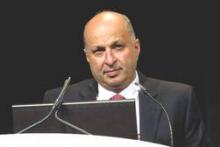ORLANDO – Partnering the PD-1 antibody pembrolizumab with pomalidomide and dexamethasone induced responses in 60% of 27 patients with heavily pretreated relapsed and/or refractory multiple myeloma in a phase II trial.
This included 1 stringent complete response, 4 very good partial responses (VGPR), and 11 partial responses (PR). Eight patients had stable disease and 3 progressed.
Further, the overall response rate was 55% (2 VGPR, 9 PR) in patients double-refractory to immunomodulatory drugs (IMiDs) and proteasome inhibitors (PIs) and 50% (1 VGPR and 5 PR) in those with high-risk cytogenetics.
“The regimen shows promising anti-myeloma activity in heavily pretreated patients” and had a “predictable and manageable side-effect profile,” Dr. Asraf Badros of University of Maryland Marlene and Stewart Greenebaum Cancer Center, Baltimore, said at the annual meeting of the American Society of Hematology.
The investigators hypothesized that blocking signaling of the programmed cell death protein 1 (PD-1) and its ligand PD-L1 with pembrolizumab (Keytruda) would activate multiple myeloma-specific cytotoxic T cells that could be further enhanced by the immunomodulator pomalidomide (Pomalyst).
The primary goal of the ongoing study is to establish the safety of the combination therapy.
In all, 33 patients received 28-day cycles of pembrolizumab 200 mg intravenous every 2 weeks plus pomalidomide 4 mg daily for 21 days and dexamethasone 40 mg weekly (20 mg for patients older than 70 years). After 24 months, responders will continue pomalidomide and dexamethasone alone until progression.
At enrollment, patients had to have relapsed and/or refractory disease after at least two lines of prior therapy including an IMiD and a PI, an ECOG performance status of less than 2, and adequate organ function.
Key exclusion criteria are an active autoimmune disease requiring systemic treatment or a history of severe autoimmune disease such as interstitial lung disease or active, non-infectious pneumonitis.
Patients received a median of three prior lines of therapy, 67% had prior autologous transplant, 89% were refractory to lenalidomide, and 70% were double-refractory to both IMiDs and PIs. The median age was 65 years (range 42-81 years), 73% were male, and 42% had high-risk deletion 17p and/or a translocation of chromosomes 14 and 16 [t(14;16)].
The median number of cycles was six and median follow-up short at 7.4 months.
The most common adverse events reported in 10% of all grades were fatigue and hypoglycemia, mostly grades 1 and 2.
The most serious adverse events in the study were pneumonia and infection, including one death due to sepsis, Dr. Badros said. Two other patients died as a result of disease progression and one because of a cardiac event.
“We reported a lot, actually, of immune-related adverse events,” he said.
In 10% of patients, the investigators noted pneumonitis, one of which was grade 3, as well as hyperthyroidism and autoimmune hepatitis. Pembrolizumab was not stopped and the pneumonitis was treated with steroids until symptoms resolved. Patients resumed the assigned doses, though one patient withdrew consent.
The pneumonitis did not appear to be associated with prior therapy and it “responded extremely quickly and well to the steroids, indicating it might be a cytokine release issue,” Dr. Badros said.
Five patients required pomalidomide dose reductions due to neutropenia in two, and one case each of rash, palpitations, and fatigue. After the septic death, antibiotic prophylaxis was started in all patients, he said.
A total of 22 patients remain on study, with 7 patients discontinuing because of disease progression.
Given the short follow-up, it is “too early to talk about progression-free and overall-survival, but the signal we are getting is quite impressive,” Dr. Badros said.
The investigators also tried to look at PD-L1 expression in bone marrow samples collected at screening and on day 1 of cycle 3. No PD-L1 expression was found on plasma cells in the first patient, about 40% expression in the second, and 100% expression in the third, which is consistent with the heterogeneity of PD-L1 expression reported previously in the literature, Dr. Badros said. PD-L1 expression on bone marrow biopsies was very hard to standardize and they are exploring various methods to assess the impact of fixation and decalcification on level of expression, he added.
Dr. Badros disclosed off-label use of pembrolizumab and no relevant conflicts of interest.


